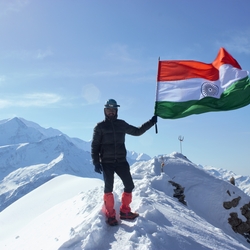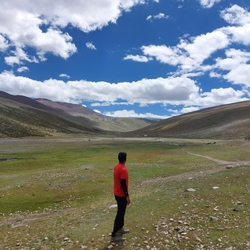If you have a knack for adventure and have sufficiently trekked in the Indian Himalayas, it might have occurred to you to attempt a mountaineering expedition. Given the unparalleled views and a feeling of being on top of the world, it sure is a tempting thought for all mountain lovers out there. However, embarking on a mountaineering expedition requires a little more than trekking experience in the Himalayas. The terrain and weather conditions are extremely challenging, requiring participants to possess technical skills and knowledge that will facilitate their climb. Yet, this does not mean that it is out of reach or impossible to go on one!
This article details out how you can gradually progress from trekking and build yourself physically and mentally for a mountaineering expedition in the Himalayas. It covers information on required skills and fitness levels to be eligible to participate in an expedition and also successfully make it to the summit. So if you are looking to level up your mountain game and scale new heights (quite literally!), you are at the right place.

Physical Fitness
Needless to say, climbing a mountain requires extremely high levels of fitness. It literally is a herculean task to climb a mountain and the mountain won’t stop to test your physical and mental endurance. Mountaineering expeditions involve performing strenuous physical activity at altitudes with low levels of oxygen, which could make even something as easy as tying your shoelaces a mammoth task. In the absence of high stamina, physical strength and endurance, climbing a mountain is close to impossible. However, you can prepare your body and mind to tackle the challenges you might encounter with rigorous training and a good fitness regimen. (Read: How to Prepare for a Mountain Climbing Expedition to better understand how you reach the desired levels of fitness and also maintain them.)
The following are a few benchmarks you can aim to achieve to prepare for a mountaineering expedition:
- Be able to run 5 km in 20-25 minutes, preferably on a slight incline.
- Be able to walk for at least 10 km with a 12 kg backpack.
- Be able to hold your breath for at least 40 seconds.
- Be able climb 40 flights of stairs while wearing a 15 kg backpack.
- Be able to do 4 sets of 15 pushups, 30 lunges and 30 squats each.
This is not a definitive marker, but merely indicative. These indicative levels are the bare minimum required to be able to participate in an expedition. If your fitness level is well above the given markers, you will be comfortable climbing a mountain and if it is below, you can always work towards it with consistency and practice.
Read about the challenges faced on a mountaineering expedition to the peak of Mt. Nun. This will help you understand the difficulties you might face and also gauge whether you are prepared for such challenges at 7000m!


Skills Required
Unlike trekking which does not require the use of any specialised equipment or technical knowledge of mountaineering procedures, expeditions require both and a lot more. If you have been on a high altitude trek, you might have used crampons or an ice axe during glacier crossings or snow ascents. The terrain on mountaineering expeditions becomes more tricky, mandating the use of specialised equipment, which requires prior training and practical knowledge. Not only are you required to know how to use an array of equipment (Read: Basic Mountaineering Gears and Their Uses), you will also need to possess technical skills that involve climbing and moving on rock, ice and snow. For example, as part of our mountaineering expedition to Bandarpunch Peak, we require participants to know how to use an ice axe, how to self-arrest using an ice axe, how to use climbing boots and crampons, how to rope-up and following queued ascent/descent along with knowledge of basic first aid.
To qualify for mountaineering expeditions in India, you should have either completed the Advanced Mountaineering Course or the Basic Mountaineering Course or should have considerable experience in high altitude trekking and rock climbing. The Basic Mountaineering Course offered by mountaineering institutes in India is a good place to start and get a firm grip over mountaineering techniques and the use of mountaineering gear. You will read more about mountaineering courses elsewhere in this article.
In spite of ample training and possessing the required skill sets, expeditions still prove to be difficult given the unpredictable nature of the mountains. You can read more about mountaineering experiences and the challenges that the mountain throws at you while you desperately try to scale it. Read Here

Gauging Your Experience Level with Bikat Rating Scale and Trek Progression Chart
At Bikat, we rate our treks and expeditions on a scale of 1-10, allowing participants to understand the difficulty level and also the experience level needed to attempt an activity that has a higher rating. For example, if you are applying for an expedition rated 7 on the Bikat Rating Scale, you would need to have participated in multiple high altitude treks rated 6. Similarly an expedition or trek rated 6 can only be attempted if you have participated in multiple treks rated 5.
If you require further assistance in understanding trek progression, you can answer a few simple questions to receive your own personalised trek progression chart based on your current level of experience.
If you are someone who has just started out with some of our smaller treks, you could attempt moderate treks before progressing to rigorous ones and eventually attempting an expedition. It is important to remember that the endurance that expeditions ask for can only be built with experience and consistency.
Mountaineering Courses in India
If you have considerable experience in high altitude trekking, a good way to progress to mountaineering expeditions would be to take part in training courses from mountaineering institutes in India. Recognised mountaineering institutes such as Himalayan Mountaineering Institute in Darjeeling, National Institute of Mountaineering and Adventure Sports in Dirang and Nehru Institute of Mountaineering in Uttarkashi all offer training in basic and advanced mountaineering. If you wish to receive further professional training, you can also enrol in the search and rescue course offered by these institutes.
Basic Mountaineering Course
The Basic Mountaineering Course lays the foundation for mountaineering in India. It introduces participants to the fundamentals of mountaineering and the necessary skills needed for the same. The course spans over a period of one month where trainees are taught techniques of movement on rock, ice and snow; theoretical and practical knowledge of navigation, map reading, mountain hygiene, weather and medicinal information and knowledge. It also provides trainees access to a vast array of literature on mountaineering, mountain environment and conservation. It is physically and mentally rigorous, gradually toughening up the trainees to have improved resistance to fatigue, hunger and extreme cold.
In case it is difficult for you to take a month out of your schedule but are still interested in learning the basics of mountaineering to familiarise yourself with the equipment and techniques of climbing, Bikat Adventures offers a 8-day course. Check details here.
Advanced Mountaineering Course
To be eligible for the Advanced Mountaineering Course, a participant should have completed their Basic Mountaineering Course with an ‘A’ Grade. This course allows participants to become expedition leaders by equipping them with the skills to plan and execute expeditions, advanced techniques of climbing on rock, snow and ice along with scientific and technical knowledge of mountaineering and its allied subjects.

IMF Mandated Team Composition
The IMF has provided strict guidelines on team compositions for mountaineering expeditions in India. All expedition teams will have a minimum of two and a maximum of twelve climbing members. The team should comprise one or more expedition leaders who are above the age of 25, have completed their Advanced Mountaineering Course, have participated in at least two expeditions to peaks above 6400m and have reached the summit of at least one peak above 6400m. The team, including the expedition leaders, should have 50% of members who have completed their Advanced Mountaineering Course with experience of expeditions. From the remaining members, a maximum of two members with experience in high altitude trekking and rock climbing may be included. The others should have completed their training of the Basic Mountaineering Course from a recognised mountaineering institute. The final composition of the team should be such that they are efficient in dealing and tackling any possible contingencies that may arise.
As a learning-based organisation, we want to help our community of outdoor enthusiasts make a systematic, informed and gradual progression in terms of their outdoor adventures. If you have any questions at all regarding the topic at hand, do not hesitate to leave us your comments and questions in the comments section below and we will be happy to assist you in any way that we can.






